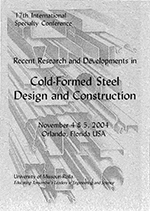Session Dates
04 Nov 2004 - 05 Nov 2004
Abstract
This paper presents two examples to the theory and finite element implementation of plasticity. The first example is on the cross-sectional behavior of trapezoidal sheeting subjected to a concentrated load. It is shown that the number of elements (and thus the number of integration points) along the comer radius are important for the correct modeling of this static problem. The second example is on the failure of first-generation sheeting subjected to a concentrated load and a bending moment. This problem, especially for large span lengths, can be solved only with explicit dynamic simulations. These are, for our research field, for the first time published here. The explicit simulations normally function with a rather simple integration scheme for plasticity; is shown that our sheeting results are very sensitive to this.
Department(s)
Civil, Architectural and Environmental Engineering
Research Center/Lab(s)
Wei-Wen Yu Center for Cold-Formed Steel Structures
Meeting Name
17th International Specialty Conference on Cold-Formed Steel Structures
Publisher
University of Missouri--Rolla
Document Version
Final Version
Rights
© 2004 University of Missouri--Rolla, All rights reserved.
Document Type
Article - Conference proceedings
File Type
text
Language
English
Recommended Citation
Hofmeyer, Herm, "Cold-Formed Steel Examples to the Theory and Finite Element Implementation of Plasticity" (2004). CCFSS Proceedings of International Specialty Conference on Cold-Formed Steel Structures (1971 - 2018). 9.
https://scholarsmine.mst.edu/isccss/17iccfss/17iccfss-session2/9
Cold-Formed Steel Examples to the Theory and Finite Element Implementation of Plasticity
This paper presents two examples to the theory and finite element implementation of plasticity. The first example is on the cross-sectional behavior of trapezoidal sheeting subjected to a concentrated load. It is shown that the number of elements (and thus the number of integration points) along the comer radius are important for the correct modeling of this static problem. The second example is on the failure of first-generation sheeting subjected to a concentrated load and a bending moment. This problem, especially for large span lengths, can be solved only with explicit dynamic simulations. These are, for our research field, for the first time published here. The explicit simulations normally function with a rather simple integration scheme for plasticity; is shown that our sheeting results are very sensitive to this.



